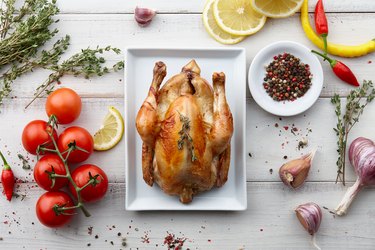
Roasting chickens are raised only for their meat and are generally young chickens between 8 and 12 weeks old, according to USDA. Usually roasted whole, these chickens have more meat per pound than a broiler-fryer type. Half a chicken includes half the breast, one drumstick, one thigh and one wing. If you're looking for a high protein source, roasted chicken is a healthy choice since all cuts are carbohydrate-free, contain no harmful trans fats or sugar and are naturally low in sodium. In addition, the USDA doesn't allow additives in fresh chicken.
Good Source of Protein
Video of the Day
Chicken is a good source of protein, which is one of the most important macronutrients you need in your diet. It's a vital building block for muscle, hair, skin and cartilage. The yield from the meat of half a roasted chicken with skin — about 10 ounces or 285 grams — supplies 68 grams of protein. The recommended daily intake of protein for adult women is 46 grams; for men it's 56 grams, according to Dietary Guidelines for Americans. Eating half a chicken would supply all of your daily requirements for protein.
Video of the Day
Calories in Half a Chicken
If you ate half a chicken, you would consume 636 calories. Dietary Guidelines estimates a daily intake ranging from 1,600 to 2,400 calories for adult women and 2,000 to 3,000 calories for adult men, depending on age and level of activity. To decrease the calories in half a chicken, remove the skin and you'll lower the calorie count to 476.
If you're restricting your calories, opt for white chicken meat over dark. For comparison, 100 grams of white meat contains 153 calories compared to 178 in dark meat for the same amount.
Dietary Fat and Cholesterol
Chicken contains 38 grams of total fat per half chicken. Of the lipid content, 15.4 grams are monounsaturated and 8.3 grams are polyunsaturated fat, which are important for helping your body absorb fat-soluble vitamins. Eating half a chicken would contribute 10.7 grams of saturated fat toward the recommended daily allowance of 10 percent of your total daily calories. Removing the skin would cut the amount of saturated fat to almost half — 18.9 grams.
There's a difference in the amount of saturated fat in dark chicken meat as opposed to white. For comparison, 100 grams of dark meat has 2.4 grams of saturated fat versus white meat with 1 gram. Chicken contains no harmful trans fat.
Although there are no specific recommended limits for cholesterol consumption, it's still important to maintain a healthy level in your body. Half a chicken contains 217 milligrams, so if you're concerned about your cholesterol count, you may not want to eat half the chicken.
Rich in B Vitamins
Chicken is exceptionally rich in niacin, which helps regulate cholesterol. A half chicken offers 21 milligrams, or 30 percent DV. Other B vitamins include: vitamin B6, 15 percent DV; pantothenic acid, 9 percent DV; riboflavin, 6 percent DV; vitamin B12, 3 percent DV; and thiamin, 3 percent DV. With 237 IU of vitamin A, the nutrition in roasted chicken contributes to normal vision and proper functioning of the immune system.
Good Source of Minerals
An excellent source of the antioxidant selenium, a half chicken contains 67 micrograms, which is more than 100 percent DV. Phosphorus is necessary for strong bones and maintaining muscle, and chicken supplies 510 milligrams or over half your DV. Iron for producing and maintaining red blood cells is in the half-chicken mix at 3.6 milligrams. Help with immune system regulation comes from 4.1 milligrams of zinc. Magnesium content is high at 57 milligrams — almost 10 percent of your DV from half a chicken. Other minerals in chicken include calcium, potassium and copper. Chicken is naturally low in sodium with only 208 milligrams per half-chicken serving.
White Meat Versus Dark
Beyond the difference in saturated fat content and calories, other differences involve the amount of protein and micronutrients in light and dark chicken meat. White meat offers more protein than dark meat, with 100 grams of light meat containing 27 grams compared to 23 grams for dark meat.
Light meat has more calcium, magnesium, phosphorus and potassium. The light meat from chicken also contains more of the B vitamins niacin, B6 and B12.
Dark meat supplies more zinc and iron. The vitamin content of riboflavin, folate and vitamin A is also higher in dark meat.
- USDA National Nutrient Database: Chicken, Roasting, Meat and Skin, Cooked, Roasted
- Dietary Guidelines 2015-2020: Nutritional Goals for Age-Sex Groups Based on Dietary Reference Intakes and Dietary Guidelines Recommendations
- Dietary Guidelines 2015-2020: Estimated Calorie Needs per Day, by Age, Sex, and Physical Activity Level
- USDA National Nutrient Database: Chicken, Roasting, Meat Only, Cooked, Roasted
- USDA National Nutrient Database: Chicken, Roasting, Dark Meat, Meat Only, Cooked, Roasted
- USDA National Nutrient Database: Chicken, Roasting, Light Meat, Meat Only, Cooked, Roasted
- USDA: Food Safety and Inspection Service: Chicken From Farm to Table